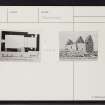Pricing Change
New pricing for orders of material from this site will come into place shortly. Charges for supply of digital images, digitisation on demand, prints and licensing will be altered.
Yell, Kirk Of Ness, St Olaf's Church
Church (12th Century)
Site Name Yell, Kirk Of Ness, St Olaf's Church
Classification Church (12th Century)
Alternative Name(s) Kirk Of Ness Chapel; Kirk Loch, North Yell
Canmore ID 68
Site Number HP50SW 1
NGR HP 53205 04897
Datum OSGB36 - NGR
Permalink http://canmore.org.uk/site/68
- Council Shetland Islands
- Parish Yell
- Former Region Shetland Islands Area
- Former District Shetland
- Former County Shetland
HP50SW 1 53205 04897.
(HP 5317 0492) Chapel (NR) (In Ruins).
OS 6" map, Shetland, 2nd ed., (1900).
The 14th century church of St Olaf, which served the parish of North Yell until 1750, since when the building has become dilapidated, and the outside covered with sand. Except for the N wall of the chancel, it is now fragmentary. Once abandoned, the church became a burial place, and the accumulation of sand outside has made necessary a new access at the SE corner of the nave (information from T Tulloch, GPO Gutcher, Yell). The successor to this church, also dedicated to St Olaf, stood at HP 5426 0268 (See (M)). A bell, last seen on the beach at Cullivoe, was dated 1694 (information from Shetland Museum 6" map and Card Index).
RCAHMS 1946, visited 1931.
The church of St Olaf as described and planned by the RCAHMS.
Revised at 1/2500.
Visited by OS (NKB) 8 May 1969.
EXTERNAL REFERENCE
Scottish Records Office
Neep. Specification of wright work in the Manse and Offices of Neep.
1830
ruce of Symbister on permanent Loan to Shetland Archives.
Antiquarian Observation (1846 - 1870)
Plans and drawings by Sir Henry Dryden in folio titled 'Churches in Orkney and Shetland', dated 1846, 1851-2, 1855, 1863, 1866 and 1870 in the Society of Antiquaries of Scotland Collection.
Publication Account (1997)
The ruins of this simple rectangular church represent the sole example of the several medieval churches of Unst to survive in recognisable form, for it was not abandoned until 1785. It occupies a classic situation on the shores of a sheltered bay on the west coast of the island. The east end of the church has been rebuilt on the original foundations, but the rest dates from the 12th century and displays characteristically small windows and a doorway in the west gable with inclined jambs and a semi-circular arch. On the underside of the lintel over the east window in the south wall, there is an incised drawing of a fish. It is tempting to see this as an example of Pictish graffiti (see chapter 7), re-used in the medieval church, but it is not typical Pictish fish (normally salmon), and this particular window is thought to be a later insertion.
In the churchyard are examples of crudely shaped stone crosses used as headstones,-similar to those at Norwick. The church went out of use in the 18th century, but its ea rli er importance may still be gauged from two unusual 16th-century tombstones preserved there. Inscribed in Low German, one commemorates Segebad Detken in 1573 and the other Hinrick Segelcken in 1585, both men being Dutch merchants from Bremen. Segebad Detken's inscription records that 'he carried on his business in this country for 52 years'.
Information from ‘Exploring Scotland’s Heritage: Shetland’, (1997).




































